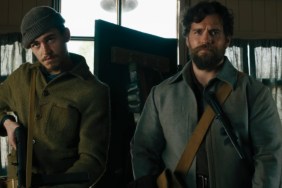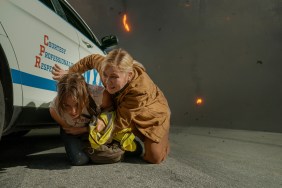On March 12, 2006, in the town of Al-Mahmudiyah just south of Baghdad, Five members of the 502nd US Infantry Regiment gang-raped a 14-year-old Iraqi girl and then murdered her and her family. Since the incident was revealed, three out of the five men have been court-martialed and sentenced, with a fourth pending trial in federal court.
Brimming with a sense of outrage, legendary director Brian De Palma (Carrie, Scarface, The Untouchables) set out to dramatize the incident, and the events leading up to and following it, using unknown actors and shot entirely in HD. The fictionalized treatment, titled Redacted, uses several innovative points-of-view to tell its story, including footage shot by one of the soldier characters on a camcorder, an alternate view shot by a fictional French documentary crew, security cameras, YouTube videos, and Al Jazeera news footage. All of this is pulled off in frighteningly realistic fashion, and brings a new energy into De Palma’s work.
De Palma sat down in New York with us to comment on this controversial new project and the process of bringing it to life.
CS: On the cover of today’s (10/10/07) New York Times there was a story of an incident nearly identical to the one that happens in your film, two Iraqi women getting shot in their car at a checkpoint. What are the considerations you need to make when you make a film about a current, ongoing, ever-evolving conflict?
Brian De Palma: You have to fictionalize it. All the stuff in the movie is inspired by real incidents, but as soon as I used the real incident a lawyer would come and say “You can’t use that, it actually happened.” It’s just so bizarre, you can use it in newspapers, you can use it on the Internet, but if you put it in a movie you have to fictionalize it. So absolutely, the incident in the movie is based on an actual reported incident, and here it is again.
CS: At the end of the film you use real photographs of Iraqi war casualties, but the subjects faces have been blacked out or “redacted”. Is that another case of legalities forcing you to change the content?
De Palma: Exactly. That caught me by surprise, ’cause they knew we were gonna use actual photographs right from the get-go. They gave us releases. All of the sudden we had to get subject releases, and you say “Well, these are war photographs
when you’re in a war zone you don’t run around getting people to sign releases.” Which caught me a little off guard. If I’d known earlier I could have recreated some of the photos, like the last photo you see in the movie is a recreation. That’s why I’m a little heated about it, ’cause I think I was misled. But that’s their work in the film. I wanted you to see their work. The movie is called “Redacted” so let’s see the redactors with their big black pens.
CS: What did you learn from making a film digitally?
De Palma: Fascinating, because of all these digital sources I found on the Internet. You know there was a site on the Internet called LEGOfest that illustrated the whole incident with LEGOs, the whole murder and killing with LEGOs. I said, “My God, this is so bizarre.” And of course I couldn’t use it because of copyright problems.
CS: Was there specific footage that soldiers shot on camcorders over there, as in the film, that you used as reference?
De Palma: No no no, we made all that stuff up. But the soldiers are really bored over there most of the time and they are walking around with video cameras, and you see this stuff in their postings and sometimes they’re put together and used in documentaries. You can’t use real stuff unless you get the rights.
CS: Is it hard to get the rights?
De Palma: Yes, it is difficult. The girl ranting about what should happen to these guys, that’s an actual Blog that I dramatized and we bought the rights to. It’s Wild Bill, that’s his blog. That’s one thing we were actually able to get the rights to.

CS: It seems like in some ways the war doesn’t make these soldiers bad, these guys show up being profoundly messed up.
De Palma: Well, I wouldn’t say that. What you want to show, much like “Casualties of War,” is how guys go so off the rails like this. I’m very specific to say that these are bad apples, they address themselves as bad apple, I have a very long scene where they talk about “I’m a wild card.” I studied a lot of these kind of crazy incidents, which go all the way back to the Yablonski murders. [Joseph Yablonski was a United Mine Workers of America union official who was murdered, along with his family, in a hit ordered by UMWA president W.A. Boyle] When they had to get the guys together to kill Yablonski they couldn’t get the right group together until they found the one nutcase they put in, much like “In Cold Blood”
you’ve gotta find that one guy that’s just a little tweaked, and he gets the other guys to go along with him. I was trying to be very even-handed on that ’cause that’s been my experience basically, and it was certainly true of “Casualties of War”. Same thing, where the sarge lost his best buddy and they just go crazy.
CS: When you were growing up did you do any military service?
De Palma: No, but my father was an orthopedic surgeon in World War II, he was on a hospital ship in the Pacific. That’s another thing you see when you talk to soldiers: they can’t talk about what they experienced. My father never said a word about it. It was interesting to see recently, Charlie Durning, who I starred as an actor in one of my early movies, you knew Charlie had something to do with the war, but we didn’t realize he was on Omaha Beach! I mean, he had a couple Purple Hearts! Suddenly 50 years later Charlie started to talk about this. They don’t want to talk about it, they can’t convey it to someone who hadn’t been there. You want to try to get that idea across, and that has a lot to do with those images at the end of the movie. These are the images. One of the more striking digital video movies I’ve seen is “Baghdad ER”. I’ve been in an ER, my father was a surgeon. I’ve spent a lot of time in a big city hospital. I’ve seen those scenes, I’ve smelled those smells. You never forget that stuff, and that was very effective.
CS: How much of the actual incident did you include and how much was fictionalized?
De Palma: I’m kind of legally restricted because I can only say it was inspired by an incident. Now, you can go on the Internet and you can put in the keywords and the incident will come up and you’ll find all the same information I did. But the characters are very much based on the characters in “Casualties of War.” The difference a little bit in this war as opposed to Vietnam is they keep re-deploying them, there’s no exit. Everybody talked about how short you were in Vietnam, you could at least go home after a year. That doesn’t happen in Iraq, they keep re-deploying you, and that again brings up the frustration and anger. The other thing is who are they recruiting? The wild card in this case was a guy who would never normally be inducted into the army, and had all sorts of SEVERE psychological problems BEFORE the incident.
CS: Why this particular project at this particular time?
De Palma: Again, it was a sequence of events. I was at Toronto, I was having dinner with some friends, someone from HDNET said, “Are you interested in making a movie for $5 million dollars on High Definition?” I said, “Fine, if I can think of a way in which I can tell a story in video that made some sense.” Then I read about the incident and said, “My God, this is ‘Casualties of War’ all over again.” Then I went on the Internet to search for information about the incident and I came up with all these unique video ways to tell the stories, and it’s like an exciting new form for me! It’s a new way to deal with narrative.
Redacted opens in limited release this Friday, November 16.









